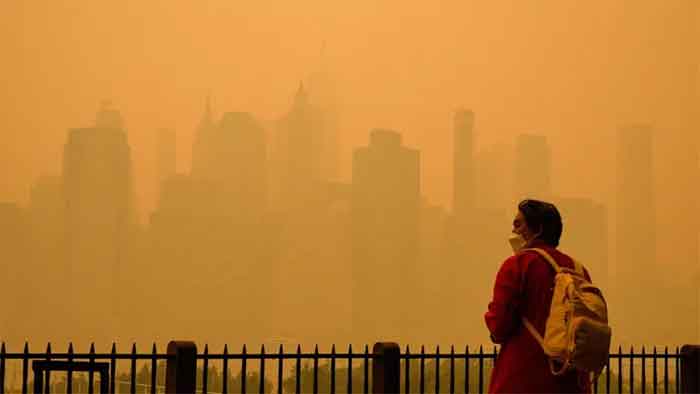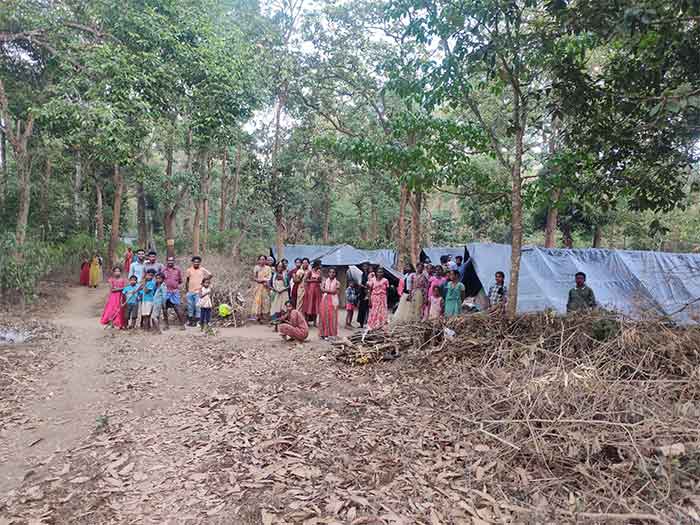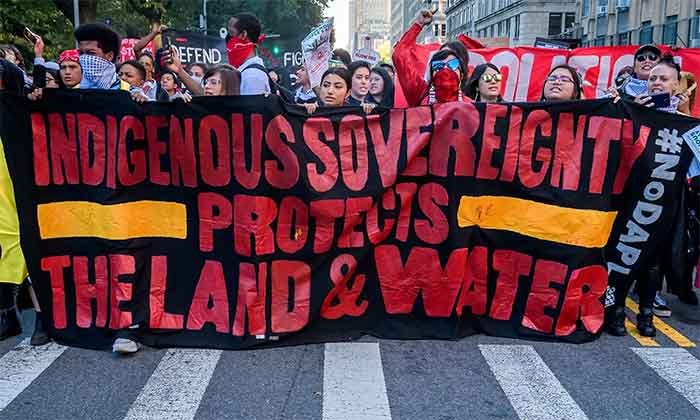
In Mexico, the intensity of the Covid-19 pandemic is increasing. With more than 480,000 cases and 50,000 deaths (third largest number of Covid-19 deaths), the country is staggering under the Coronavirus pandemic. While the entire country is experiencing the impact of the pandemic, indigenous communities represent the demographic section hardest hit by health catastrophe. Data from Coneval, the national government’s social development agency, has shown that the Covid-19 fatality rate in Mexico’s poorest 427 municipalities is 14.1. On the other hand, the fatality rate in the country’s 54 wealthiest municipalities is 8.1, “meaning that people who live in impoverished parts of the country are almost twice as likely to die if they become sick with Covid-19 than those who live in affluent areas.”
In Benito Juárez, for instance, “the coronavirus fatality rate is 9.4 whereas in the predominantly indigenous municipality of Tlachichuca, Puebla, the rate is 30.” Inegi, the national statistics agency, has shown “that 3,527 people who identify as indigenous have tested positive for Covid-19 and 650 of them died. Those figures yield a fatality rate of 18.4 per 100 cases, well above the national rate of 10.9…Yucatán, which has a large Mayan population, has recorded the most Covid-19 deaths among indigenous people with 163. That figure accounts for 25% of the indigenous Covid-19 death toll.” The acute crisis of existence being faced by indigenous people is leading to desperation and consequently, grotesque suicides. The case of Mexican farmer named Samuel, living in one of the poorest villages of Mexico, Ocosingo, intensely expresses the predicament of indigenous people in Mexico: “A day after learning he was infected with the coronavirus, an indigenous Mexican farmer named Samuel hanged himself from a tree. And he remained hanging there for hours because no one had protective gear to bring the body down”.
Neoliberal Healthcare and Structural Inequalities
A statement (translated from Spanish) released by the Mayan Community Collective of Hopelchén enunciates the dangers present to indigenous communities and serves as an introduction to the systemic oppression of indigenous people in Mexico: “The risk of Covid-19 affecting large groups of the population is high because, in addition to the high rates of diseases such as diabetes and hypertension suffered by the inhabitants of Hopelchén, they also present a high vulnerability derived from their permanent exposure to the pesticides that are used in the enormous agricultural extensions of the region. The existing environmental fragility, the huge deforested areas, the pollution of the water and the large amounts of pesticides that are applied in agriculture…generate conditions of vulnerability and of enormous risk in the municipality.”
Mexico’s indigenous population, numbering approximately 17 million (21.5% of the entire citizenry) and the largest in the Americas, is inordinately suffering from the pandemic due to its historically situated socio-economic oppression. The National Council for the Evaluation of Social Development Policy estimates that “11.8 million indigenous people in Mexico are in situations of poverty and extreme poverty. Social deprivation indicators show that 3.7 million are lagging in education, 1.9 million in access to health services, 9.4 million in access to social security, 3.8 million in food, 3.4 million in housing quality and space and 6.9 million in basic housing services, of which 12.8% lack piped water, 26.9% do not have sanitation services, 13.9% of homes have dirt floors and 58.8% cook with wood or charcoal”. In the three Mexican states with the highest indigenous population, “the vast majority of children live under the poverty line on less than two dollars a day. In Chiapas, 81.7 percent of children live below the poverty line; 77.1 percent in Guerrero; and 66.9 percent in Oaxaca. This means that the majority of children in these indigenous communities go to bed hungry”. Moreover, there is a disparity between the availability of water for indigenous and non-indigenous communities: 21% of the Mexican indigenous population living in the rural areas lacks access to water, compared to 16.8% for the non-indigenous rural population. The results of water scarcity are evident from the current scenario in Oaxaca where indigenous women belonging to the Ayutla community are coping with a heightened water demand amid the Covid-19 pandemic and have started an organized non-violent struggle against water unavailability.
These socio-economic inequalities are proving to be lethal for the indigenous people during the Covid-19 pandemic. In the domain of health services, for instance, Mexican indigenous severely lack proper infrastructure: while non-indigenous municipalities have 377 clinics and 336 beds, the municipalities with high indigenous presence have only 63 clinics and 31 beds per 100 thousand inhabitants; further, the rate of doctors in non-indigenous municipalities is 670 per 100,000 inhabitants, compared to 86 doctors in municipalities with indigenous presence.
While most indigenous people are unable to access health services, those who access face two major barriers. Firstly, the health services which indigenous people utilize are underfunded, undersupplied and suffer from a deficiency of human resources. The abysmally low public health expenditure, comprising of 5.5% of the GDP (among the lowest across OECD countries), is the primary reason behind the degraded public health services offered to indigenous people. Through a largely hollow and overburdened public health system, shortages in medicinal supplies are produced, forcing indigenous people to visit local pharmacies and significantly increase their out-of-pocket health expenditure. The current out-of-pocket health expenditure in Mexico remains high at 41% of total health expenditure, an indication of the fact that indigenous people are bearing the burden of an exceptionally expensive health system intent on impoverishing them.
Secondly, indigenous individuals accessing health services encounter language barriers when health professionals, being inadequately trained in regional languages, fail to communicate with indigenous patients. In Mexico, “it seems clear that the demand for culturally and linguistically relevant health care services has not been appropriately addressed through existing policies and programs.” The roots of the present-day culturally homogenous health system in Mexico can be located in the country’s wholesale replication of the neoliberal model which, at that time, was being tested in USA and elsewhere. In the 1990s, like other Latin American countries, Mexico too imported the competitive and privatized model of healthcare from USA that promoted privatization and profit extraction. A cardinal component of this neoliberal health model was the destruction of regionally rooted epistemic ecologies and the consequent standardization of everyone as crass consumers and passive objects of health practices.
This project of cultural colonization inevitably collided with indigenous interpretations of health and committed what Boaventura de Sousa Santos has labeled “epistemicide”: the destruction of the knowledge architectures of the Global South by the power forces of the Western World. On the one hand, indigenous people viewed health “as the harmonious coexistence of human beings with nature, with themselves and with others in pursuit of well-being. The indigenous concept of health melds physical, mental, spiritual and emotional elements, from the point of view of both individuals and communities, and has political, economic, social and cultural components.” It is due to this holistic understanding of health that indigenous people in Mexico, in the words of Irma Pineda, Representative of Mexico to the UN Permanent Forum on Indigenous Issues, continue to perceive the Covid-19 pandemic “as a disease that has to do with our own neglect as humanity, with the fact that we have not taken good care of nature, and have not been respectful to our Mother Earth, to our natural environment. In this sense, there is the idea that we, indigenous peoples, are ourselves one with Mother Earth, that we are one with everything that surrounds us, with nature, with the environment, and that, to the extent that we have neglected it, we have hurt ourselves as people, as humanity, and that in a certain way the disease is the response of the Earth to remind us that we have to take care of each other”.
On the other hand, Eurocentric dynamics of imperialism constructed and economized health as a domain of capital accumulation, totally unidimensional, ignorant of socio-ecological contexts and pathologizing diseases in medicalized frames, divorced from cultural structures. In this dialectics of colonization-decolonization, language became an important target for imperialists because it served for the indigenous people as the symbolic medium for articulating resistance and grounding one’s identity in the existential soil of sustainable living. In the contemporary time, we are witnessing the ramifications of this epistemicide and cultural war on language as neoliberal standardization strangulates intercultural translation and erases indigenous identities.
Through the subversion of health system for the indigenous people, a generalized existential impoverishment took place in the form of malnutrition, increased infant mortality rates and decreased life expectancy. According to the United Nations Department of Economic and Social Affairs (UN DESA), “Indigenous peoples suffer from poorer health, are more likely to experience disability and reduced quality of life and ultimately die younger than their non-indigenous counterparts.” There are numerous indicators statistically substantiating the claim that Mexican indigenous communities’ conditions have deteriorated: The gap in the life expectancy of indigenous and non-indigenous people is 6 years; 44 percent of indigenous children are malnourished, compared to only 17 percent of non-indigenous children; while the infant mortality rate is nine deaths per thousand live births in the richest municipalities, indigenous communities have an infant mortality rate 58% higher and a life expectancy five years lower than the national average and ten years lower than in Mexico City, the largest urban center of the country; anaemia afflicts 40% of indigenous women, compared to the national average of 26%; in the indigenous state of Guerrero, the maternal mortality rate is 28.3 per 10,000 live births, compared with the national rate of 5.1 per 10,000 live births; the mortality rate associated to pulmonary tuberculosis among indigenous peoples is twice that of the non-indigenous population in Mexico. Overall, the poor health situation and co-morbidities of indigenous people in Mexico greatly increases their immunological vulnerability to Coronavirus infection.
On top of an insufficient health infrastructure, the North American Free Trade Agreement (NAFTA) is another factor that has contributed to the degradation of indigenous health. Through NAFTA, Mexico was required “to accept imports of subsidised and overproduced American corn. The dumping of this cheaper corn undermined the viability of smallscale corn farmers, forcing them to abandon the land, and thoroughly disrupted historical food traditions. Mexico is now well on its way to making the nutritional transition from an indigenous to an industrial food economy. About 10% of Mexican children remain stunted or wasted, but more than two-thirds of Mexican adults are now overweight or obese—the highest proportion in Latin America. Unsurprisingly, type 2 diabetes is rampant…nearly 15% of Mexican adults have type 2 diabetes; this condition is now second only to heart disease among the leading causes of death.”
Indigenous People and Socio-ecological Conflicts
Apart from the appalling health conditions of indigenous people, stemming directly from the neoliberalization of healthcare and the consequent destruction of public health, Mexican indigenous collectivities also bear the brunt of socio-ecological conflicts and the corresponding dispossession of basic existence. Socio-ecological conflicts in Mexico are related to the resistance against the global extractive empire and bolster the penetration of capital into indigenous territories, thus perpetuating what mining companies have been doing for decades: rob and run.
In 2019, 21 political activists, environmental defenders and human rights advocates belonging majorly to different indigenous groups were murdered. These crimes were primarily committed “in the states of Chiapas, Chihuahua, Morelos, Oaxaca, Puebla, Tabasco and Veracruz, in the context of territorial conflicts, opposition and resistance to megaprojects involving infrastructure, extractive industries and energy production.” To give an example, the peasant activist Samir Flores Soberanes, member of the Peoples’ Front in Defense of the Earth and Water of Morelos, Puebla and Tlaxcala (FPDTA-PMT) and Indigenous Governance Council (CIG), a Zapatista-affiliated organization of indigenous groups, was murdered in February 2019 due to his opposition to the Morelos Integral Project , two thermoelectric power plants in Huexca, as well as to the Apatlaco River aqueduct and gas pipeline in Amilcingo.
2019 was not the only year when Mexican indigenous people had to fight against mining companies. Between 1995 and 2015, 503 cases of repression were reported against activists involved in socio-environmental conflicts. In 2017, 31 murders were recorded, the majority of which involved indigenous activists struggling against the environmental violence of extractivism. 90% of these murders, occurring in Chihuahua, Guerrero, Veracruz, and Oaxaca, home to an estimated 3.5 million indigenous people, go unpunished, highlighting the immense impunity enjoyed by the mining bourgeoisie. In 2018, similarly, 14 land and environmental defenders were killed with the case of Margarito Díaz González being representative of other murders. Margarito Díaz González was the leader of the Wixárica indigenous community and was murdered in September 2018. This killing was part of the larger campaign to intimidate the Wixárica indigenous people of the Wirikuta region into accepting the construction of an environmentally disastrous dam. Earlier, two indigenous land defenders had been killed in the same region, suggesting a pattern of politically motivated killings.
The repression and outright killings of indigenous people in Mexico are propelled by the country’s structurally subordinated status as a primarized economy and its dependence on tourism. Mexico is a major producer of silver, gold, bismuth, fluorite, cadmium, molybdenum, arsenic, zinc, graphite, manganese and copper. Jimena Valverde, Mexico’s general coordinator for mining, says, “Mexico is a mining country. The mining industry represents the third productive activity, after the oil and the tourism industries, excluding money sent by Mexicans living in other countries.” Mining’s importance for Mexico is further indicated by the Mining Law which has established the extraction of hydrocarbons and minerals as “preponderate over any other use that the land may be put to, such that this will always have preference over any other activity that involves harnessing the land or subsoil.”
A major intensification of the extractive sector in Mexico occurred under the right-wing presidency of Vicente Fox (2000-2006) and Felipe Calderón (2006-2012), both belonging to the National Action Party (PAN), when mining concessions were unabatedly given to capitalists, regardless of indigenous consultations: “The twelve-year period of PAN government on the federal level coincided with a boom in commodity prices on the global level. During this time, the Mexican government doled out 28,810 mining concessions, covering an area of 60.9 million hectares, equal to 31% of the country’s territory…these concessions were granted without the knowledge of the local population, thereby violating the right of indigenous communities to “free, prior and informed consent”…Mining companies did not have to pay royalties and a low effective income tax translated into their paying just 1.2% of gross earnings between 2005 and 2011, when international prices for minerals and metals were soaring.”
The Mexican mining sector was again consolidated by Enrique Pena Nieto in 2013 through the Energy Reform that that allowed private agents to take advantage of unexploited Mexican oil and gas reserves. Dawn Paley, a journalist, notes how the Energy Reform was interlocked with the militarization of hydrocarbons-rich regions under the pretext of “Drug War” and aggravated the atmosphere of violence for indigenous people and other social sectors: “In December 2013, the Congress approved constitutional changes to open up even more of Mexico’s hydrocarbons industry to the participation of private transnational businesses. At the same time, Mexican states rich in hydrocarbons—such as Chihuahua, Coahuila, Nuevo León, Tamaulipas, San Luis Potosí, and Veracruz—have been militarized as part of the war on drugs. Some of these regions have shown high levels of forced displacement because of the severe drug-related violence. In this context, the government of Mexico intends to attract massive foreign investments to tap into the country’s energy resources.”
Indigenous communities in Mexico are trying to revolt against the extractivist empire of the Global North and Hubert Matiúwàa, a Mexican poet belonging to the Tlapanec community, represents the anti-extractivist resistance brewing in the Global South. His discussion of indigeneity and capitalism expresses the class struggle being waged against the imperialist nations: “In order to analyze our origin philosophy, an epistemology must be mapped from our own language, based on non-Eurocentric categories. This mapping would contribute to rising above colonization and alienation from our own knowledge, reconstructing identity and fertilizing an epistemological resistance by the peoples who have been threatened by the capitalist system, including mining companies, biosphere reserves, etc, that have so deeply altered our ways of life”.
The exploitation of mining in Mexico has fused with tourism projects to further dispossess indigenous people. In 2018, 49.6 million tourists visited Mexico and in 2019, Mexico served as the major tourist destination for US residents. Tourism accounts for 8.5% of GDP, 5.8% of full-time paid employment and 77.2% of service exports. This heavy reliance on tourism has given rise to anti-indigenous policies wherein ancestral territories are stolen from indigenous people for the construction of tourist destinations, devoted to the enjoyment of European and American recreational investors. The process of dispossessing indigenous territories was greatly aided by state-sponsored laws and free market policies such as NAFTA. In 1992, president Carlos Salinas made amendments to the law allowing foreign corporations to acquire ejidos i.e. communal lands used for agriculture where the community members have usufruct rights. As ejidos were unjustly acquired by foreign corporations, rural indigenous people were left homeless and without any means of subsistence. By 2007, “over 62 thousand instances of alienation of social property lands had been registered in the National Agrarian Register, not only transforming the agricultural use of the lands to touristic and development purposes, but also its relationship with the communities.”
NAFTA accelerated the expropriation of ejidos through “agricultural liberalization”, a euphemism for the violent disruption of communitarian property-holding indigenous ethos which was characterized by “collective land ownership, a preference for alimentary self-subsistence, expectations of social reciprocity and communal solidarity, and aspirations of autonomy.” NAFTA’s neoliberal policies eliminated subsidies for agricultural products provided by the Mexican government, removed tariffs on imported agricultural goods and abolished price regulations set up by marketing boards. This was the supposed process of ensuring “equal trade opportunities” where USA continued to subsidize its products like corn and strong-armed an imperialistically ravaged nation into destroying its indigenous farmers’ existence. As a natural result of “liberal” policies, the price of American corn drastically dropped by 50% and the entire Mexican market got inundated by the unending supply of this cheap American corn. Unable to compete with imported corn, the income of indigenous and non-indigenous farmers reduced from 1,959 pesos a month in 1991 to 228 pesos a month in 2003. Consequently, the indigenous farmers, incapable of eking out a living from agriculture, had to sell their lands. Agriculture employs 45 % of the indigenous economically active population (EAP) and the extent of the havoc wreaked by NAFTA was enormous: almost 1.3 million agriculture jobs were lost in Mexico due to NAFTA.
Through NAFTA and various laws, indigenous people in Mexico were coerced into leaving their lands and seeing luxury tourist destinations occupy their ejidos. In the city of Cabo San Lucas, for example, ejidos were expropriated to accommodate the pressures of the tourism development model. A more recent example of tourism-related dispossession is the Mayan Train Project which “will affect the different Mayan communities, their ecocultural resources, and the largest tropical forest in America after the Amazon”. The train “will pass through the Selva Maya (Mayan Forest) and several protected areas, including the UN-designated Calakmul Biosphere Reserve, the second-largest expanse of tropical forest in the Americas, after the Amazon. Covering 42,300 km2, the Selva Maya is the largest tropical rainforest in North and Central America and the second largest in the continent as a whole. It hosts an extraordinary biological diversity with twenty different ecosystems and a large number of endemic species…The Calakmul Biosphere Reserve, which spans an area of 7,232 km2, recognized as a Mixed World Heritage Site by UNESCO, has one of the largest jaguar populations in Central America”.
The Mayan train project has already been promised financial support by Carlos Slim, Mexico’s richest man with a net worth of $51.2 billion. The project has additionally proven to be a feast for foreign corporations such as Canadian Bombardier, the French Alstom and the Chinese Railway Construction Company which are seeking to get involved. Like all tourism project, the Mayan Train Project, too, is expected to employ indigenous people in low-skill and low-paid jobs like painting facilities, washing floors and bathrooms, serving in food and beverage shops for tourists. This is income creation. An indigenous individual affected by a tourist project expresses the contorted idea of this “income creation” when he says, “companies and people with money come and [local people] become employees again. The process is repeated. [These people say] “You give us the land, I put in the supplies, you work for me and I will give you 100 pesos daily.” The employee is the campesino, the owner of the land.”
The entanglement of indigenous people in socio-ecological conflicts has contributed to their subjection as an impoverished populace, displaced from their traditional lands and exploited by predatory capitalists. After the destruction of agriculture by NAFTA, the displaced indigenous people were absorbed by the informal economy and maquiladoras where they faced hyper-exploitative economic relations. Indigenous people are over-represented in the informal economy with eight out of ten indigenous Mexicans having informal jobs. These indigenous informal workers earn 45.5 percent less than the non-indigenous population, an expression of the labor market segmentation done by capitalists to reduce unit labor costs.
Maquiladoras are firms operating in the Export Processing Zone (EPZ) at the US-Mexico border, a type of Free Trade Zone (FTZ) where cross-border duties, taxes and national regulations don’t work. In a nutshell, maquiladoras represent the purest form of dehumanizing exploitation. In the maquiladoras, women and girls make up more than half of the workforce and indigenous women, in particular, have been facing muscular violence for decades. Human rights activists have said that “young indigenous women from different communities throughout Mexico are largely represented but under-reported among those who have been murdered or disappeared en route to work in the maquiladoras since the early 1990s.” The female indigenous maquila workers, apart from experiencing patriarchal violence, are also paid extremely low wages and it has been acknowledged that “It is not possible to live on what the maquiladoras pay and this has made it so many women workers cannot take care of their own children. With such little pay, they are not able to provide the food that their children need.”
After NAFTA, there has been a growth in maquiladoras and the consequent exploitation of female workforce as Mexican programs favoring specific industries have been eliminated and firms have switched to maquiladoras to continue importing inputs duty-free to Mexico. But female indigenous workers have not passively accepted the super-exploitation of maquiladoras and the following statement by a female textile worker in those modern-day sweatshops reflects the growing class consciousness of the workers: “The dresses we make are beautiful, for very fashionable women. They’re incredibly expensive! They sell them in the best stores in the United States and they cost $200 or $300. And what do we get? We make 45 pesos [about U.S. $1.00] per dress. Incredible, don’t you think? We spend ten hours a day in front of a sewing machine to make a man rich and we don’t even know him. And the worst of it is that we continue doing it, some not even making the minimum wage, without complaining, asleep at the wheel, watching time go by, years in front of the sewing machine.”
As the Covid-19 pandemic progresses in Mexico, the stark structural inequalities suffered by the Mexican indigenous population are being unveiled. Even during the pandemic, the risk to indigenous land defenders in Mexico is increasing. Iván Vargas González, an indigenous activist protesting a highway being built through forests claimed by the Otomí-Mexica indigenous community, was detained by the state police and his whereabouts are unknown. After this event, construction resumed with protection from the National Guard and police. The company involved in the construction is Teya-Autovan, a subsidiary of Grupo Higa, owned by Juan Armando Hinojosa Cantú, one of the main business partners of President Enrique Peña Nieto’s six-year term. Despite being disadvantaged in the form of health care inequality and socio-cultural repression, indigenous communities in Mexico are ready for the future revolt and the oppression of objective conditions is slowly seeping into indigenous subjectivity. A Mexican mural made by indigenous people involved in protests against energy projects reflects the determined struggle being waged against the exploitative practices of the Global North: “Freedom is not conquered on your knees, but standing on your feet. Giving back hit by hit, inflicting wound by wound, death by death, humiliation by humiliation, punishment by punishment. Let the blood flow in streams because that is the price of freedom.”
Yanis Iqbal is a student and freelance writer based in Aligarh, India and can be contacted at [email protected]. His articles have been published by different magazines and websites such as Monthly Review Online, ZNet, Green Social Thought, Weekly Worker, News and Letters Weekly, Economic and Political Weekly, Arena, Eurasia Review, Coventry University Press, Culture Matters, Global Research, Dissident Voice, Countercurrents, Counterview, Hampton Institute, Ecuador Today, People’s Review, Eleventh Column, Karvaan India, Clarion India, OpEd News, The Iraq File, Portside and the Institute of Latin American Studies.
Originally published in LA Progressive
SIGN UP FOR COUNTERCURRENTS DAILY NEWSLETTER













































